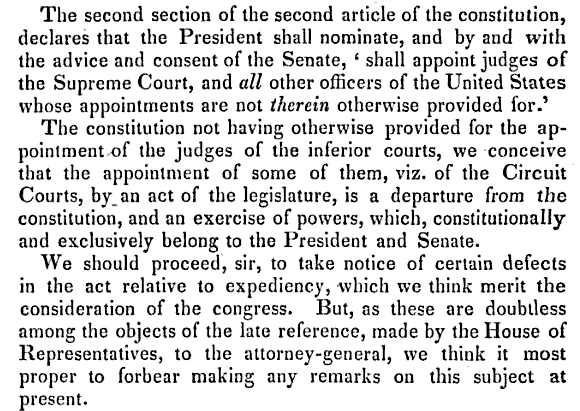Emily Bazelon assembles the numbers to show that the four vacancies on the D.C. Circuit lead to too many Republican-dominated panels:
The D.C. Circuit had four open slots from 2006 (out of 11) until last month, when the Senate finally confirmed an Obama’s nominee, Sri Srinivasan, by a vote of 97–0. That came after the long and bitter filibuster of Obama’s first pick, Caitlin Halligan. With Srinivasan on the bench, there are four judges chosen by Democratic presidents, four chosen by Republicans, and six more senior judges who also hear cases. Five of those senior judges were chosen by Republicans (in fact, 15 of the past 19 vacancies have been filled by GOP presidents, according to Nan Aron of the liberal court-watching group the Alliance for Justice). The D.C. Circuit hears cases in panels of three. Because the senior judges pick up a sizable share of the workload, “almost 80 percent of the panels in 2013 were composed of exclusively or a majority of Republicans,” Moshe Marvit writes in Dissent. “The results of this partisan court are not surprising. Many of the D.C. Circuit’s recent decisions have skewed heavily to the right.”
Emily said out loud what the President obviously won’t, but is at the heart of his announcement to appoint three new judges to the court. Instead, the President justifies his appointments, because the court is short-staffed.
There are 11 seats on the D.C. Circuit Court. When I first took office, there were two vacancies. Since then, two more judges have retired. That means there are four vacancies that needed to be filled. And by February of this year, more than one-third of the seats on the nation’s second highest court were empty. I mean, imagine if a third of the seats on the highest court — the Supreme Court — were empty. We would rightly consider that a judicial crisis. If we want to ensure a fair and functioning judiciary, our courts cannot be short-staffed.
This is not the case. The D.C. Circuit is notoriously underworked. The caseload, in contrast with all other courts of appeals, is dwindling. The problem isn’t that the court is lacking judges. The problem is that the existing judges, most of whom were nominated by Republican Presidents, are voting in ways that progressives do not like. Emily’s column makes that point abundantly clear.
Look no further than the Canning decision, which was argued, fittingly enough, by Miguel Estrada, himself filibustered back in the day. At the time, Jay Carney called the decision “unprecedented“:
“The decision is novel and unprecedented,” Carney said. “It contradicts 150 years of practice by Democratic and Republican administrations.”
The President hints at that problem with these comments:
The D.C. Circuit is known as the second highest court in the country, and there’s a good reason for that. The judges on the D.C. Circuit routinely have the final say on a broad range of cases involving everything from national security to environmental policy; from questions of campaign finance to workers’ rights. In other words, the court’s decisions impact almost every aspect of our lives.
Now there’s nothing wrong with taking this position. Presidents appoint judges who reflect their view of the law. I think that’s an important part of any presidency (something Obama did not focus much on in his first term, perhaps due to spending so much time on the ACA). But, let’s be real (as I noted in this post). Emily’s comments accurately reflect why the President wants to get these three judges confirmed to the D.C. Circuit, and is using the strategy of nominating three at once.
Now, I do not agree with efforts to move three seats from the D.C. Circuit to other courts. That smacks of politics that should be separate from our courts. Also, the three nominees should all be easily confirmed. Though most progressive groups support them, I can’t imagine they are enthused the same way conservatives were with nominees like Janice Rogers Brown or Brett Kavanaugh (maybe not after Obamacare).
Update: A report from Politico makes a similar point:
To hear President Barack Obama tell it, the motives underlying his latest partisan fight have nothing to do with politics.
But there’s no question that the ideology of the courts, and of one particularly powerful court, are at the heart of the dispute.
…
Despite the president’s complaints about politics infecting the confirmation process, it’s beyond debate that his liberal supporters are eager to see more of his judges on the bench. Liberal activists are confident the addition of Obama appointees to the mix would temper the rulings of a court that, say some on the left, has been on a kind of conservative ideological crusade.
However, when asked Tuesday if concern about the direction of the influential court played into Obama’s decision to offer up a slate of three D.C. Circuit nominees, White House Press Secretary Jay Carney insisted that the driving factor was the largely logistical matter of making sure the court was firing on all cylinders.
“The president believes that this court, which is commonly referred to as the second highest court in the land, should be fully staffed,” Carney said.


